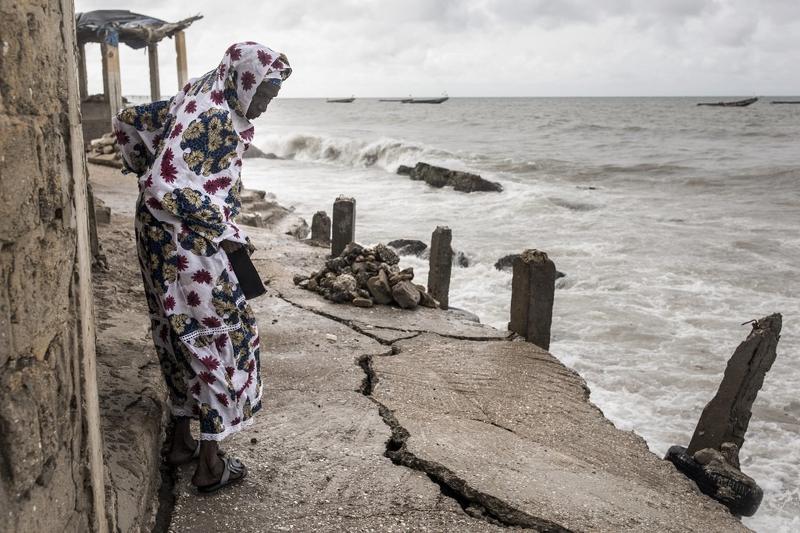 A woman looks down a newly formed crack in the walk way which leads to the mosque in Bargny, Senegal on September 18, 2020. Fishing villages like Bargny have been fighting the rising seas for decades, with hundreds of houses lost and families displaced. (JOHN WESSELS / AFP)
A woman looks down a newly formed crack in the walk way which leads to the mosque in Bargny, Senegal on September 18, 2020. Fishing villages like Bargny have been fighting the rising seas for decades, with hundreds of houses lost and families displaced. (JOHN WESSELS / AFP)
Climate change is causing oceans to rise quicker than scientists’ most pessimistic forecasts, resulting in earlier flood risks to coastal economies already struggling to adapt.
The revised estimates published Tuesday in Ocean Science impact the two-fifths of the Earth’s population who live near coastlines. Insured property worth trillions of dollars could face even greater danger from floods, superstorms and tidal surges. The research suggests that countries will have to rein in their greenhouse gas emissions even more than expected to keep sea levels in check.
The revised estimates published Tuesday in Ocean Science impact the two-fifths of the Earth’s population who live near coastlines
ALSO READ: Wang Yi: Climate change big highlight of China-EU ties
“It means our carbon budget is even more depleted,” said Aslak Grinsted, a geophysicist at the University of Copenhagen who co-authored the research. Economies need to slash an additional 200 billion metric tons of carbon — equivalent to about five years of global emissions — to remain within the thresholds set by previous forecasts, he said.
The researchers built on the United Nation’s Intergovernmental Panel on Climate Change’s models, many of which only consider the last 150 years, by incorporating data going back several centuries. The new observations show about a half-meter of sea rise by the end of the century can now be expected with just a 0.5 degree Celsius rise in temperatures. Oceans could rise more than 1 meter at 2 degrees Celsius, a trajectory that will be easily passed under current climate policies.
ALSO READ: EU leaders break stalemate over climate target, claim deal
“The models we are basing our predictions of sea-level rise on presently are not sensitive enough,” Grinsted said. “To put it plainly, they don’t hit the mark when we compare them to the rate of sea-level rise we see when comparing future scenarios with observations going back in time.”

The conclusions follow last month’s warning that rising temperatures have melted 28 trillion metric tons of ice — equivalent to a 100 meter thick sheet of ice covering the entire UK — making the worst-case climate scenarios more likely.
The new methodology for tracking sea level change could help insurance companies, real estate developers and city planners erecting tidal-defense systems.
READ MORE: Europe said to look at zero emissions by 2050
“The scenarios we see before us now regarding sea-level rise are too conservative – the sea looks, using our method, to rise more than what is believed using the present method,” Grinsted said, adding that his team at the Niels Bohr Institute is in touch with the IPCC about incorporating its results in next year’s sixth Assessment Report.


